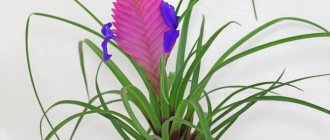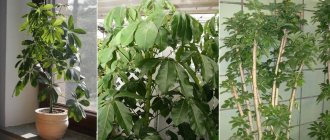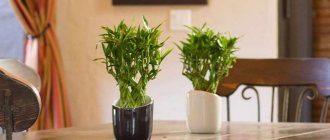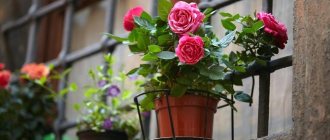Growing Schefflera Janine
This is one of the most beautiful subspecies. It has rosette-shaped foliage, colored green-yellow, which in the sun acquires white spots and streaks. As it is also called, “Schefflera arborescens” grows easily and without special care in humid and warm climates; you just need to place the pot with it in partial shade.
Features of care
- A correctly chosen place is the key to the healthy development of this flower. It does not tolerate direct rays of the sun, but cannot maintain the bright color of the leaves without light, so you need to choose a place where it will be illuminated by a diffused stream.
- In winter, the room temperature should not be lower than 14°C, and in the summer heat - exceed 25°C.
- Moderate watering is the best hydration. Schefflera can die from waterlogging, but very dry soil will harm it. Therefore, during cold periods you should not water it often, and during hot periods you should additionally humidify the air around it or place a tray with pebbles next to it. Periodically, you need to wipe the leaves with a damp sponge and expose it to the open air.
- From spring to early autumn it is necessary to fertilize. During this period, the active growth of this plant occurs. Therefore, such assistance should be provided every week.
Home care
Trimming
The plant does not require pruning of leaves. It is produced only with strong growth and spreading branches. Basically, pruning of branches is performed only for reproduction.
This method is perfect for cuttings or propagation by air layering.
Watering
The best moisture is moderate watering.
If a plant is flooded, it may die from excessive overwatering.
But the plant does not like rocky, dry soil.
Therefore, the flower is watered as the soil dries.
A small stick or pencil is inserted into the soil.
Attention! If there is still damp soil on the object, you should wait a while with watering.
If the pencil remains dry, the plant needs urgent watering. In winter, watering should be reduced. Especially if the plant is in a dormant period. And in hot weather, watering is increased.
The air around the flower is also additionally moistened. Room temperature water and a spray bottle work well. Sometimes a container with a flower is placed on a tray with expanded clay or pebbles.
This helps the plant breathe more and prevent its roots from rotting. At the same time, the container must have a good drainage system. Periodically, the exclusive leaves of the flower are wiped with a damp cloth or sponge.
Landing
To replant this amazing flower, purchase soil for palm trees is used. Holes are drilled at the bottom of the container. The flower needs to choose drainage. Expanded clay, broken brick, pebbles, gravel or finely crushed clay fragments are perfect for this.
The bottom of the pot is filled 1/4 with material. Then soil is poured up to half the container. A plant with a well-developed root system is installed in the center. Then the flower is covered with soil again. The soil should not be compacted as the soil should be loose. In dense soil, the plant breathes poorly, which affects growth and health.
Transfer
Fully mature young flowers need to be replanted.
Typically, transplantation is carried out once every two to three years.
Large pots are selected for this. The containers should be 3-6 cm larger than the previous ones.
Transplantation is carried out by transshipment.
Since "Schefflera" reacts poorly to crushing the root system.
When transshipment, the roots of the plant will not be damaged. The full earthen lump is transferred to a new container. The root system is covered with earth to the very edges. Then “Janine” needs to be watered generously.
Important! From mid-spring after the snow melts until October, the plant needs feeding.
During this period, “Janine” is actively growing. Therefore, every week the flower is enriched with vitamins and minerals.
Growing
The flower tolerates warm and humid climates well. Can grow at home. Containers can be placed on loggias, glazed balconies, and greenhouses. The plant feels great on high shelves of cabinets and window sills.
Reproduction
The pet reproduces by air layering, purchased seeds and cuttings. In the latter case, the old woody seedlings are cut off with scissors. The sections are treated with resin, which easily heals plant wounds.
The cuttings are placed in a growth stimulation solution for two hours. After the procedure, the cuttings are immediately planted. You should not put them in water. Land mixed with humus and sifted river sand is perfect. Then the seedlings are covered with polyethylene, a cut plastic bottle or glass container.
It is important that the container allows light to pass through. Such a mini-greenhouse will serve as a reservoir in which the plant can actively grow. It is necessary to maintain a temperature of 20-23°C.
When propagating by seeds, containers and soil are prepared in advance. You can use purchased land. But this method of reproduction is used extremely rarely.
And the probability of germination is 50:50. Seeds should only be planted in early spring in March and April. They will not sprout at any other time. Planting material is leveled on the ground and sprinkled with soil.
The planting depth should not exceed 0.5-1.0 cm. The seeds require a home-made greenhouse, in which an optimal thermal regime of 20-23°C must be constantly maintained. The temperature should not fall below 18°C.
When propagated by air layering , planting material is grown specially.
By itself, “Janine” does not produce its own layers.
Therefore, a small incision is made on the flower stem.
Then natural forest moss is applied to it.
The layering site is wrapped in a plastic bag.
The place and distance next to it must be kept moist at all times.
The very first shoots appear after 60 days. They must be carefully cut and planted in prepared containers. The cutting area of the main plant must be treated with resin.
Temperature
In winter, the room temperature should not fall below 13-14°C. And in the hot summer heat, the plant cannot be left for a long time at temperatures above 25°C. The optimal growth temperature can vary between 14-25°C.
Attention! It is not recommended to leave the flower near heating devices.
Despite the heat-loving nature, being near a battery for a long time can negatively affect the appearance and health of the flower. Once a week the plant must be exposed to fresh air.
Lighting
A correctly chosen place of growth will be the key to good and healthy development of “Janine”. The plant does not like direct sun exposure.
But it will not be able to maintain its exotic leaf color without light. Therefore, the container with the flower must be installed in partial shade, where the “Scheffler” will receive a constant diffused flow.
Benefit
"Janine" belongs to the genus "Schefflera". Therefore, she is endowed with all the advantages of her ancestor. This type of plant is very popular in the West and Europe.
Thanks to the unique, openwork and exotic colors of the leaves, the flower looks great in all rooms. It complements the interior and attracts everyone with its unusual appearance. It also purifies the air and absorbs computer rays. The flower gives off excellent calming energy.
Perhaps readers may also be interested in the following types of Schefflera:
- Bianca;
- Tree-like.
Reproduction Schefflera Janine
It can be produced:
- cuttings;
- seeds;
- air layering.
Wooden cuttings are cut with a sharp knife, treated with a hormonal solution and immediately planted in a substrate prepared in advance. It consists of sifted sand and peat. And then cover with a regular bag, glass container or cut plastic container. For this type of reproduction it is necessary to create a temperature of 22°C.
Seeds are used extremely rarely. They can be planted in early spring under homemade greenhouses and constantly maintain a temperature of at least 18°C.
Schefflera itself does not produce layering for propagation; it must be grown. First, an incision is made on the trunk of the plant, then moss is applied and everything is wrapped in polyethylene. This place must be constantly kept moist. The first shoots should appear in two months. They are cut and planted in pots.
Benefits, signs and superstitions
- Many people believe that sheflera can improve the microflora of a residential building, ridding its residents of negative energy through absorption.
- In addition, green space helps reduce aggression, anger and hatred towards each other. But “cleaning” begins to take effect only if the plant has reached 8 months of age.
- Life's superstitions say that you should enter a purchased property for the first time with a cat and a shefflera.
- Some determine the state of life and the strength of a marriage by the appearance of the flower. If it is rich in color and has many juicy and large leaves, then the marriage is strong and the spouses love each other.
Signs are a rather unusual thing; not many people believe them, much less follow them. But what is there cannot be avoided!
Schefflera transplant Janine
It is necessary to purchase special soil for palm trees. Be sure to choose good drainage; medium-sized expanded clay, gravel or ceramic fragments will do. They need to fill the pot about a quarter full.
Young plants and already mature ones need replanting. This must be done every two years. The pot is selected with a diameter 5 mm larger than its previous counterpart. Transplantation is carried out by transshipment, during which the roots will not be damaged. Then the earthen lump with the flower is transferred to a pot and covered with soil to the brim. Then water it abundantly.
Types and varieties
The following types are used in indoor floriculture:
- eight leaf;
- radiate;
- tree-like;
- palmate.
Based on these species, breeders have developed new varieties of shefflera, which we will consider a little below.
Eight leaf
The plant got its name from the number of leaf blades, which ranges from eight to twelve. The leaves are lanceolate, pointed at the apex. Their length reaches 30-40 centimeters, and their width is about ten. The leathery leaves have several shades of green, and the veins on them are light cream.
Radifolia
Due to the shape of the leaf plate, it is also called star-leaved. You can recognize it by the number of leaves extending from the red-brown petiole. The sixteen leaves are ovoid at first. As the plant grows, they become longer, but remain blunt at the ends. Their length is fifteen centimeters and their width is five. The bright green leaves have a shiny leathery surface and light veins. This species is the most popular among gardeners. It is necessary to note the rapid growth of Schefflera radiata. Based on this species, varieties with yellow-green and golden-yellow leaf blades have been bred.
Tree-like
The plant is a tree that grows up to 1.2 m, with shoots extending from a straight trunk. This species is native to Southeast Asia. The number of leaves located on long petioles ranges from seven to sixteen. The leaves, which are up to fifteen centimeters long, reach eight centimeters in width. The size and shade of the leaves may vary depending on the variety.
Palmate
The homeland of palmate schefflera is New Zealand. In its homeland, the tree grows up to eight meters and resembles a palm tree. Eight ellipsoid-shaped leaves are on long petioles reaching twenty centimeters. The length of the leaves ranges from fifteen to thirty centimeters. It differs from the radiate species in its compactness.
This may be interesting: Monstera - caring for a beauty with a scary name
Janine
Schefflera Janine stands out for its variegated foliage. Light dots and streaks are scattered on the dark green background of the leaves. This variety is distinguished by the fact that it tolerates shading well and does not lose its variegated color.
Nora
The Nora variety is variegated. Narrow green leaves are covered with yellow specks. The edge of the leaves is framed with teeth. Schefflera Nora is distinguished by its unpretentiousness and lush crown.
Gold Capella
The variety was bred on the basis of the tree-like Schefflera. The tree has a lush crown with bright green leaves covered with golden spots.
Gerda
The Gerda variety prefers diffused light, moisture and fertile soil. The leaves of the plant are variegated, yellow-green in color. The height of the plant depends on the conditions of detention, and varies from 0.5 to 2.5 meters.
Luzeana
The Luzeana variety is distinguished by openwork leaves with yellow-green streaks. Shiny leathery plates add additional decorativeness.
Bianca
Plants of the Bianchi variety have short leaves, the length of which does not exceed eight centimeters. The leaf blade has denticles along the edge, covered with a white border. Beige spots are visible at the base of the leaves. The variety is decorative due to the shape and color of the leaves.
Custer
This variety, bred by breeders, is more suitable than others for growing in our apartments. The plant does not grow more than 120 centimeters. Its leathery, dark green leaves are medium in size.
Diseases and pests Schefflera Janine
They are only associated with improper care. But timely identification and quick elimination of the causes of the disease will not affect the decorativeness of the plant. Mostly they encounter the following diseases:
- active shedding of leaves - caused by low temperatures or excess moisture. It is necessary to immediately move the flower to a warmer place;
- brown edges or darkened spots are a sign of poor watering or drafts;
- Root rotting - excess moisture. It is urgent to transplant the plant into new soil;
- the appearance of various pests (thrips, mites or scale insects) on the surface of the leaves. There are several methods to get rid of them. The simplest thing is to wipe the leaves, especially their insides, with a soapy solution. If this procedure does not help, insecticides or fungicides should be used.
Schefflers Janine are distinguished by their beauty, originality and height (can reach 2 meters). Its appearance will attract the attention of any guest and add a tropical touch to the interior of the room.
Description and photo
There are about 200 different species of Schefflera in the wild. This plant is sometimes called a tree plant. Latin name: "Schefflera Arboricola Janine". This amazing plant stands out among other representatives of the flora.
"Schefflera" is endowed with the most beautiful leaf shape. They look like a rosette-shaped, spreading structure. And their structure resembles an amazing umbrella with rays of the sun. The colors of the flowers are different. Sometimes they are completely emerald, but in most cases they are amber with snow-white spots. In the sun they acquire snow-white streaks in the middle of the leaf.
Unfortunately, this exotic pet does not bloom in indoor conditions. But the unusual shape and color of the leaves completely compensates for the lack of flowering.
This plant can be immediately noticed among other green spaces, thanks to the unusual shape of its leaves. It looks like an umbrella with rays.
From a botanical point of view, all Schefflera are trees, shrubs or vines with complex leaves dissected into several lobes. Growing on long (on average up to 20 cm) petioles, they resemble open umbrellas with grouped umbrellas.
The shape of the leaves gives the plant a special elegance: depending on the type, their segments can be narrow and pointed or wide, ovoid, reminiscent of chestnut or oak leaves, with wavy, finely toothed or pronounced serrated edges, decorated with yellow and white spots.
The plant is native to Taiwan, Hawaii, tropical zones of Southeast Asia, and Australia.
Brief description of cultivation
- Lighting. Schefflera at home needs bright, diffused light; the best place is an eastern window sill.
- Watering. Moderate, avoid excess watering; in summer 2-3 times a week, in winter 1 time every 7-10 days.
- Transfer. Every 2-3 years, annually replacing the top layer of soil in the pot.
- The soil. Nourishing, lightweight, breathable.
- Humidity. High humidity, regular watering is recommended.
- Temperature. In summer 20-25 degrees, in winter 18-20 degrees, but not lower than 12 degrees.
- Fertilization and nutrition. During the growing season, once every 2 weeks, apply liquid fertilizer for decorative foliage plants.
- Specific care. Requires support, sometimes pruning to achieve a bushy form.
- Spreading. Apical cuttings, pruning, seeds.
Schefflera: proper care and transplantation
Watch this video on YouTube











